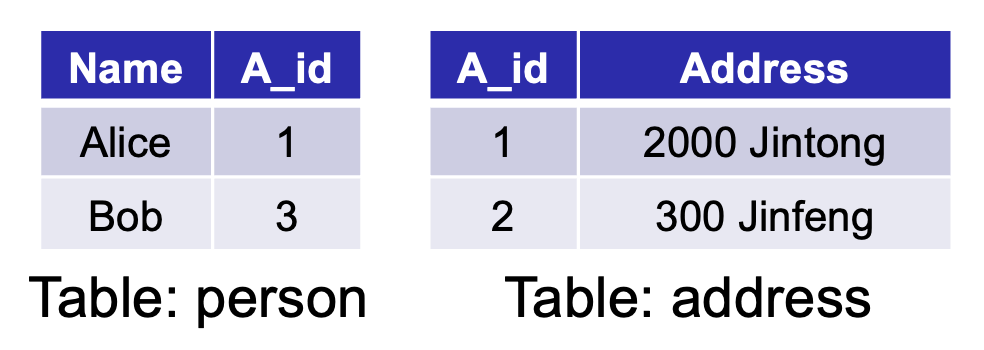Title: "[[Join]]"
status: DONE
tags:
- MySQL
- NOTE
- Lec3
Author:
- AllenYGY
created: 2023-11-17T18:18
updated: 2024-03-21T21:45- NATURAL JOIN
SELECT *
FROM table1
NATURAL JOIN table2;
默认JOIN所有共同的attribute
- JOIN ON
SELECT *
FROM table1
JOIN table2 ON table1.column_name = table2.column_name
JOIN table3 ON table2.column_name = table3.column_name;
- JOIN USING
SELECT *
FROM table1
JOIN table2 USING (column_name)
JOIN table3 USING (column_name);
- LEFT/RIGHT/FULL JOIN
SELECT *
FROM left_table
LEFT JOIN right_table ON left_table.column_name = right_table.column_name;
SELECT *
FROM table1
RIGHT JOIN table2 ON table1.column_name = table2.column_name;
SELECT *
FROM table1
FULL JOIN table2 ON table1.column_name = table2.column_name;
- Are you tired of condition checking in cross table queries?
The NATURAL JOIN operator associates two tables by the common attributes.
After NATURAL JOIN, the duplicated attributes are omitted.
SELECT * FROM city NATURAL JOIN country
is implemented as
SELECT city.country_id, city.last_update, city_id, city, country
FROM city, country
WHERE city.country_id = country.country_id AND
city.last_update = country.last_update
Join Condition
- Join conditions define in which condition the tuples are associated.
- Two tuples are associated if
- NATURAL: all common attributes have the same value.
- ON <predicate>: the predicate is evaluated to be true.
- USING
For example, these queries are equivalent.
SELECT first_name, last_name, address, district, postal_code
FROM customer NATURAL JOIN address
SELECT first_name, last_name, address, district, postal_code
FROM customer JOIN address ON customer.address_id = address.address_id AND customer.last_update = address.last_update
SELECT first_name, last_name, address, district, postal_code
FROM customer JOIN address USING (address_id, last_update)
JOIN
- A JOIN without any condition is same as a cartesian product.
Sometimes more than two tables are joined together.
NATURAL JOIN
- The NATURAL JOIN operator associates two tables by all the common attributes.
基于两个表之间的相同列名来进行连接。当使用自然连接时,数据库系统会自动查找两个表中列名相同的字段,并将它们用作连接条件,返回一个新表,其中包含了这些字段的所有数据。
SELECT * FROM city NATURAL JOIN country
is equivalent to
SELECT city.country_id, city.last_update, city_id, city,country
FROM city, country
WHERE city.country_id = country.country_id AND
city.last_update = country.last_update
SELECT *FROM table1 NATURAL JOIN table2 NATURAL JOIN table3
The query is understood as
SELECT* FROM (table1 NATURAL JOIN table2) NATURAL JOIN table3
只保留相同的部分
Notes:
- The predicate in the ON clause is user-defined, which is very flexible.
- NATURAL and USING combine the common attributes. But ON duplicates common attributes.
JOIN type
当需要无法匹配的部分时
- Sometimes users want to keep the unmatched tuples after joining two tables.
OUTER JOIN can handle it.
-
table1 NATURAL LEFT OUTER JOIN table2
All tuples in table1 are in the result. For the unmatched tuples, the values of the attributes from table2 are NULL, meaning “unknown”. (NULL values will be introduced in following labs.) -
table1 NATURAL RIGHT OUTER JOIN table2
The unmatched tuples from table2 are kept. -
table1 NATURAL FULL OUTER JOIN table2
All tuples (from both table1 and table2) are kept. -
NATURAL is the join condition.
On the opposite of OUTER, INNER JOIN does not keep the unmatched tuples.
Same as JOIN. “INNER” is usually omitted.
Suppose we try to join this 2 tables

- LEFT OUTER JOIN
SELECT * FROM person NATURAL LEFT OUTER JOIN address

- RIGHT OUTER JOIN
SELECT * FROM person NATURAL RIGHT OUTER JOIN address

- FULL OUTER JOIN
SELECT * FROM person NATURAL FULL OUTER JOIN address

